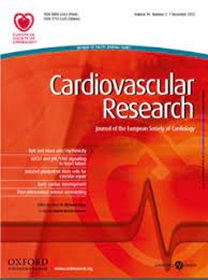Renal denervation achieves its antiarrhythmic effect through attenuating macrophage activation and neuroinflammation in stellate ganglia in chronic heart failure
IF 10.2
1区 医学
Q1 CARDIAC & CARDIOVASCULAR SYSTEMS
引用次数: 0
Abstract
Aims Renal denervation (RDN) is widely investigated in multiple studies of sympathetically driven cardiovascular diseases. While the therapeutic potential of RDN for ventricular arrhythmia has been reported, the mechanisms responsible for its antiarrhythmic effect are poorly understood. Our recent study showed that macrophage expansion-induced neuroinflammation in the stellate ganglion (SG) was a critical factor for cardiac sympathetic overactivation and ventricular arrhythmogenesis in chronic heart failure (CHF). This study investigates if and how RDN decreases ventricular arrhythmias by attenuating neuroinflammation in cardiac sympathetic postganglionic (CSP) neurons in CHF. Methods and Results Rat CHF was induced by surgical ligation of the left anterior descending coronary artery (LAD). At 12 weeks after LAD ligation, completed bilateral RDN was achieved by surgically cutting all the visible renal nerves around the renal artery and vein, followed by applying of 70% ethanol around the vessels. Immunofluorescence staining and Western blot data showed that expression of granulocyte-macrophage colony-stimulating factor (GM-CSF) and its receptor-α subunit (GM-CSFRα) in SGs was increased in CHF rats. RDN not only reduced CHF-elevated GM-CSF levels in kidney, serum and SGs, but also attenuated macrophage expansion and neuroinflammation in SGs from CHF rats. Using flow cytometry, we confirmed that RDN reduced the percentage of macrophages in SGs, which is pathologically increased in CHF. RDN also decreased CHF-enhanced N-type Ca2+ currents in CSP neurons and attenuated CHF-elevated cardiac sympathetic nerve activity. ECG data from 24-hour continuous telemetry recording in conscious rats revealed that RDN improved CHF-induced heterogeneity of ventricular electrical activities and reduced the duration of spontaneous ventricular tachyarrhythmias in CHF rats. Conclusions RDN alleviates cardiac sympathetic overactivation and ventricular arrhythmogenesis through attenuating GM-CSF-induced macrophage activation and neuroinflammation within SGs in CHF. This suggests that manipulation of the GM-CSF signaling pathway could be a novel strategy for achieving the antiarrhythmic effect of RDN in CHF.通过减轻慢性心力衰竭患者星状神经节中巨噬细胞的激活和神经炎症,肾脏去神经支配发挥抗心律失常作用
目的 肾脏去神经支配(RDN)被广泛用于交感神经驱动的心血管疾病的多项研究中。虽然有报道称 RDN 对室性心律失常具有治疗潜力,但对其抗心律失常作用的机制却知之甚少。我们最近的研究表明,巨噬细胞扩张引起的星状神经节(SG)神经炎症是慢性心力衰竭(CHF)中心脏交感神经过度激活和室性心律失常发生的关键因素。本研究探讨了 RDN 是否以及如何通过减轻 CHF 中心脏交感神经节后神经元(CSP)的神经炎症来减少室性心律失常。方法和结果 通过手术结扎左前降支冠状动脉(LAD)诱发大鼠 CHF。在 LAD 结扎 12 周后,通过手术切断肾动脉和肾静脉周围所有可见的肾神经,然后在血管周围涂抹 70% 的乙醇,完成双侧 RDN。免疫荧光染色和 Western 印迹数据显示,CHF 大鼠 SG 中粒细胞-巨噬细胞集落刺激因子(GM-CSF)及其受体-α 亚基(GM-CSFRα)的表达增加。RDN 不仅能降低 CHF 升高的肾脏、血清和 SG 中 GM-CSF 水平,还能减轻 CHF 大鼠 SG 中巨噬细胞的扩张和神经炎症。我们使用流式细胞术证实,RDN 降低了巨噬细胞在 SGs 中的比例,而巨噬细胞在 CHF 中会病理性增加。RDN 还能降低 CHF 增强的 CSP 神经元中的 N 型 Ca2+ 电流,并减轻 CHF 升高的心脏交感神经活动。对有意识大鼠进行 24 小时连续遥测记录的心电图数据显示,RDN 改善了 CHF 诱导的心室电活动异质性,并缩短了 CHF 大鼠自发性室性快速性心律失常的持续时间。结论 RDN 通过减轻 GM-CSF 诱导的巨噬细胞激活和 CHF 大鼠 SG 内的神经炎症,缓解了心脏交感神经过度激活和室性心律失常的发生。这表明,操纵 GM-CSF 信号通路可能是实现 RDN 在 CHF 中抗心律失常效果的一种新策略。
本文章由计算机程序翻译,如有差异,请以英文原文为准。
求助全文
约1分钟内获得全文
求助全文
来源期刊

Cardiovascular Research
医学-心血管系统
CiteScore
21.50
自引率
3.70%
发文量
547
审稿时长
1 months
期刊介绍:
Cardiovascular Research
Journal Overview:
International journal of the European Society of Cardiology
Focuses on basic and translational research in cardiology and cardiovascular biology
Aims to enhance insight into cardiovascular disease mechanisms and innovation prospects
Submission Criteria:
Welcomes papers covering molecular, sub-cellular, cellular, organ, and organism levels
Accepts clinical proof-of-concept and translational studies
Manuscripts expected to provide significant contribution to cardiovascular biology and diseases
 求助内容:
求助内容: 应助结果提醒方式:
应助结果提醒方式:


